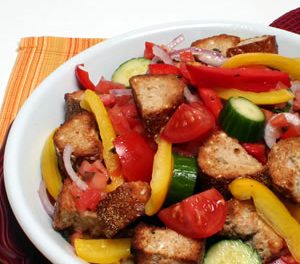Fat is a nutrient that is both much feared and much loved. It is a source of pleasure, guilt and confusion for many people. While eating some fat is both necessary and health promoting, eating too much fat is detrimental. When over-consumed, fat may contribute to some major health risks: heart disease, cancer, excess body fat, high blood pressure and adult onset diabetes.
The scientific consensus on the health risks of eating too much fat is so strong that all of the lists of national nutritional recommendations have a low fat message. The AICR, for instance, recommends we "limit consumption of fatty foods, particularly those of animal origin and choose modest amounts of appropriate vegetable oils."
Fats or lipids are loosely defined as substances that are not soluble in water. Food fat comes in three basic forms--the triglycerides, phospholipids and sterols-- and each type of fat has specific roles in the body. When people talk about fat they are usually referring to the triglycerides, which make up about 95% of the fat in food and are the compact storage form of energy in the body. The phospholipids, because of their unique structure, have key roles in cell membranes, and the sterols, such as cholesterol, are important building blocks of some hormones.
A number of factors affect the appropriate fat intake of an individual. For most healthy adults, an optimal fat intake is somewhere between 10 and 30% of calories consumed. People living with heart disease, those trying to lose body fat and some athletes should be near the 10-15% end of this range. Others, who are having trouble keeping weight on, have low cholesterol levels, or who choose mostly mono-unsaturated fats such as olive and canola oils can safely choose a diet closer to the 25-30% end of this range. This translates to a suggested range for daily fat intake of 22-66 grams for someone who needs to eat about 2000 Calories to stay in balance and 34-100 g/day for a person who needs 3000 Calories.
To put these numbers in perspective, here is a short list of foods and their respective fat contents: a double cheeseburger (50 g), one chicken wing (10 g), a tablespoon of butter (14 g), 3 oz of baked salmon (9g), a 1 oz slice of cheese (9 g), and 1 cup of 2% milk (5 g).
All of these foods have greater than 30% of calories from fat, and some of them, such as a serving of chicken wings, would exceed nearly anyone's daily fat budget in a single sitting. This is why foods such as these should be enjoyed in moderation and only occasionally. In the plant kingdom, high-fat foods are the exception rather than the rule, while in the animal kingdom the opposite is true. In fact, most animal foods have to be processed (sometimes elaborately) to make them lower in fat.
Looking at whole plant foods, the only common foods that have greater than 30% of calories from fat are nuts, soybeans, avocados and olives. Otherwise, most whole plant foods have zero to three grams of fat per serving. Be aware, though, that processed plant foods such as potato chips and foods cooked in oil or coated with high-fat dressings, as some salads are, may have as much or more fat than animal foods.
Take note that all of the common food sources of cooking fat-- butter, regular margarine, corn oil and olive oil-- contain 100% of calories from fat, and all have about 14 grams of fat and about 120 calories per tablespoon. Be aware also that light olive oil is simply lighter in color or flavor than its regular counterpart. Light margarines, however, do have fewer calories and grams of fat per serving than regular margarines, because they are fluffed with water. Your best bet with these substances is to limit your use of all of them.
The basic low fat message is clear. Healthy eating involves limiting fat intake, especially saturated fat intake, by choosing a diet rich in plant foods and limited in foods that come from animal origins.
Amy Joy Lanou, Ph.D.
AICR









